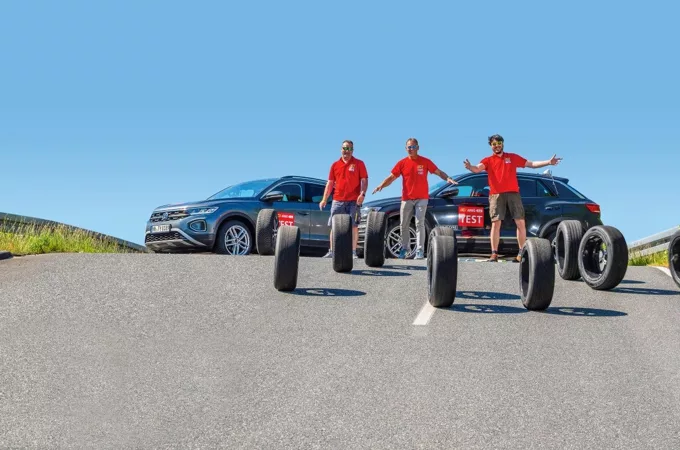All-season tires put to the test
All-season tires put to the test
Nine 215/50 R 18 all-season tires for compact SUVs were tested on a VW T-Roc in a test conducted by ACE, the Austrian Automobile, Motorcycle and Cyclist Association (ARBÖ) and GTÜ. All-season tires are an increasingly popular alternative to seasonal tire changes, as they offer a solution for different weather conditions. They have to perform convincingly both on snow in winter and on hot asphalt in summer. Two products were rated as “highly recommended”, while no tire failed completely.
Performance of all-season tires in the winter test
The winter tests took place at a test site in Sweden. Various hazardous situations, such as emergency braking on a snow-covered road, were simulated here. When braking from 40 km/h, the tires tested were very close to each other. The braking distance ranged from 19.4 meters for Falken to 20.9 meters for Pirelli. For comparison, a summer tire was fitted, whose braking distance of 51.8 meters clearly showed the dangers of summer tires in winter. When starting off in the snow, Michelin impressed with a value of 23.3 meters, while Toyo came last with 27.5 meters. In terms of handling, Michelin and Continental performed well, while Toyo also failed to impress here.
Test results of all-season tires in wet conditions
On a wet road, the Continental tire performed best when braking from 80 km/h, coming to a halt after just 29 meters. Pirelli and Bridgestone also showed good results, while Toyo finished behind with 33.5 meters. Goodyear, Pirelli and Continental stood out in terms of handling, as they were precise to drive but showed slight understeer in corners. Michelin, Bridgestone, Falken and Toyo, on the other hand, performed less well in terms of handling. All tires performed passably well in aquaplaning, with no significant downward deviations.
Results on dry roads
On dry asphalt, the summer tire used for comparison achieved the shortest braking distance of 30.6 meters, which none of the all-season tires could surpass. Toyo, which had previously brought up the rear, surprised with a braking distance of 36.7 meters and thus took third place. Only Pirelli (35.6 meters) and Continental (36.1 meters) performed better. The worst performers in this test were the tires from Goodyear and Falken with 42.0 meters and Vredestein with 42.4 meters. The gap between the best and worst tires was therefore 6.8 meters, which is roughly the length of a delivery van. In terms of handling on dry roads, however, all tires were close to each other.
Conclusion: The test winner Continental offers the best overall balance between all tested conditions, closely followed by Michelin. Falken was convincing in the winter test, but showed weaknesses in the summer setting. Toyo performed well on dry roads, but failed to impress in other categories. Overall, three tires were rated as recommended and four as conditionally recommended. None of the tires tested failed completely. It also became clear that summer tires are extremely dangerous in winter and should not be used under any circumstances.


